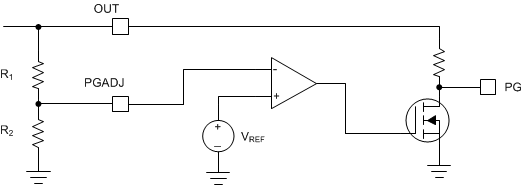SBVS360A February 2020 – November 2020 TPS7B85-Q1
PRODUCTION DATA
- 1 Features
- 2 Applications
- 3 Description
- 4 Revision History
- 5 Pin Configuration and Functions
- 6 Specifications
- 7 Detailed Description
- 8 Application and Implementation
- 9 Power Supply Recommendations
- 10Layout
- 11Device and Documentation Support
Package Options
Mechanical Data (Package|Pins)
- DRC|10
Thermal pad, mechanical data (Package|Pins)
- DRC|10
Orderable Information
7.3.2.1 Adjustable Power-Good (PGADJ)
One unique feature of this LDO, as shown in Figure 7-2, is the ability to adjust the power-good threshold through the use of a resistor divider. The adjustable power-good threshold allows the PG threshold to be set to the desired level to further assist in transient detection or sequencing requirements. If this feature is not desired, then tie the PGADJ pin to GND and the default PG threshold is used. For more information on how to calculate the power-good threshold, see the Section 8.1.8.2 section.
 Figure 7-2 Typical Use of Power-Good Adjust Pin
Figure 7-2 Typical Use of Power-Good Adjust Pin